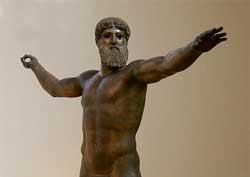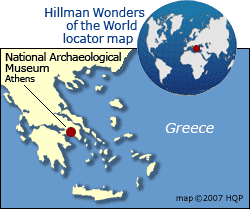National Archaeological Museum
 Why the National
Archaeological Museum
in Athens is special
Why the National
Archaeological Museum
in Athens is specialIt houses the world's finest collection of Greek antiquities, spanning prehistoric to Byzantine times. The National Archaeological Museum's primary strengths are sculpture and pottery.
National Archaeological Museum tips and insights
Naming controversies
Two of the National Archaeological Museum's treasures are wrapped in naming controversy:
- Statue of Poseidon (see photo)
Most scholars in Greece believe the right hand was holding a trident, therefore the subject is Poseidon. Other experts think the object was a lightning bolt, therefore he's Zeus. You decide.
- Death Mask
of Agamemnon
Its 19th-century discoverer Heinrich Schliemann was certain that the subject of this Mycenaean masterpiece was the monarch Agamemnon. Today's archaeologists say that chronological dating proves that the subject lived in Mycenae on the Peloponnesus Peninsula of Greece before (and therefore could not possibly be) Agamemnon.
They include a marble artwork showing the Aphrodite threatening a satyr - and a copper figure of a boy jockey riding a bareback horse.
Outstanding non-sculptures
These artworks of Greece include the prehistoric Cycladic figurines, the Thera frescoes, and the red- and black-figured vases.
How to avoid crowds
The National Archaeological Museum attracts throngs of people in the summer. Try to visit it during one of the three daytime periods when you are least likely to encounter the tour-bus crowds in Athens, Greece. They are early morning, lunchtime, and late afternoon.
Location in Greece



